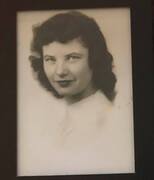 On Sunday, Americans honored their moms by bringing them flowers, taking them out to eat, and spending time visiting either by phone or in person. When did this idea of celebrating mothers begin and how did it come to America? Thousands of years ago, in ancient Greece and Rome, pagans held spring festivals honoring their mother goddesses. Rhea is the Greek mythological mother of the Olympian gods and goddesses and was worshipped as the goddess of fertility and the mountain wilds. In statues, Rhea is depicted as a matronly woman, seated on a throne flanked by lions. In ancient Rome, Romans celebrated “Magna Mater” (Great Mother), however, these celebrations became so wild and notorious that the Roman government banned Magna Mater’s followers from Rome. What do mothers and wild parties have in common? Ask the ancient, pagan Romans. They had a way with parties. Immediately after the crucifixion of Christ, Christians celebrated Mary as the mother of God, “Theotokos” in Greek and “Mater Dei” in Latin. By the 7th century, Christians around the world set aside January 1st as a special day to honor Mary. Throughout the month of May, Mary is celebrated in many churches as a role model of a perfect mother. In America, Mother’s Day was the brainstorm of Anna Jarvis in 1868. Jarvis wanted to establish a day where Americans would unite for peace and friendship. In 1868, she created a committee to establish “Mother’s Friendship Day,” a day set aside for former Civil War combatants and their families to reunite and form friendships. When Jarvis died, her daughter, also Anne Jarvis, took up the call. Anne Jarvis wanted a day to honor all moms and was upset that America’s holidays were too male dominated. Jarvis sponsored the first U.S. celebration of Mother’s Day at St. Andrew’s Methodist Church in Grafton, West Virginia, in the early 1900s. Anne Jarvis was so successful in promoting the holiday that in 1914, the U.S. Congress passed a law designating the second Sunday in May as Mother’s Day. President Wilson issued a proclamation that on the first Mother’s Day, Americans should show the flag in honor of those mothers whose sons had died in war. Mother’s Day has become a major American and commercial holiday. It is the third largest holiday for sending cards. Americans take their mothers out for brunches or lunch on Mother’s Day, and it has become a source of great wealth for the card, restaurant, and flower industries. The founder of Mother’s Day, Anne Jarvis, decried the commercialization of the holiday she championed. In fact, in 1948, Jarvis was arrested for disturbing the peace during a protest against Mother’s Day! The Classical Historian family expresses great admiration and gratitude to all mothers. Mothers are responsible for passing on culture, manners, standards, education, and morality. The author of this article is the 10th of 11 children. He’s glad his mom sacrificed so much to give life and love to so many. Thanks Mom! And we wish all moms this Sunday a Happy Mother’s Day!
0 Comments
In the United States of America, Christmas was established as a federal holiday on June 26, 1870. It is a celebration of the birth of Jesus Christ, the man Christians believe is the son of God and the savior of the world. It has its roots in ancient times and is celebrated around the world.
For the first few hundred years after Jesus Christ, his birthday was not celebrated. Instead, Epiphany, when the three kings from separate places of the world visited Christ, was the focus of Christians. The visit of the Magi symbolized that salvation was open to the whole world, not just one select nation. Later, early Church Fathers promoted the idea that the birth of Jesus Christ should be celebrated. December 25, 336, marks the first day Christians officially celebrated the first Christmas on Earth, and it was in the Roman Empire. The date of Christmas and some American traditions have pagan roots. In the Roman Empire, December 25th was the day of “natalis solis invict” (the Roman birth of the unconquered sun), and the birthday of Mithras, the Iranian “Sun of Righteousness.” Saturnalia, a Roman festival that honored the sun, lasted from December 17th to December 23rd. The winter solstice, the darkest day of the year, also falls a few days before December 25th and had been celebrated by pagans. Early Christian Church leaders believed that days that had been set aside to honor pagan gods could be changed to honor Christianity. It was thought that people would more easily accept Christianity and move away from paganism by replacing pagan celebrations with Christian ones. The festival of Saturnalia honored the Roman god Saturn. Romans had a public banquet, gifts were exchanged, there was much partying, and servants were served by their masters. Singers performed in streets, and baked cookies shaped like men. While some Christians dislike any association with pagan traditions, Saint Augustine of Hippo (354-430) wrote, “We hold this day holy, not like the pagans because of the birth of the sun, but because of him who made it." In Great Britain and in the fledgling English colonies in America, the birth of Christ was remembered with joy and festivities until the Puritans, led by Oliver Cromwell, outlawed celebrating Christmas in 1645. Puritans believed that celebrating the birth of Christ was a sign of decadence and a disgrace to Christianity. In the English Colonies, the English separatists also believed in worshipping Jesus without ceremonies and made celebrating Christmas a crime. Few in the United States know or would understand how celebrating Christmas with parties, special meals and drinks, was a crime in most of the English colonies until the 18th century, but it was. Although it was no longer a crime, celebrating Christmas in the 1700s was primarily a quiet and solemn religious event, involving no frivolity. In the 1800s, Americans' views on Christmas changed a great deal. One author, Washington Irving, wrote fictitious stories of how Christmas had been celebrated in England before the Puritans took over, and some of these stories caught on in American practices. German immigrants brought with them the practice of placing evergreen branches and trees in home during winter as a reminder of life during hard times. And, Catholic immigrants brought the tradition started by Saint Francis of keeping small nativity scenes in their homes. By the late 1800s, most Americans celebrated Christmas. In 1870, President Grant and Congress declared Christmas, the celebration of the birth of Jesus Christ, savior of the world, a national holiday. Questions
 On Halloween 2023, millions of American families will carve pumpkins, most children will don costumes and go from house to house asking for candy. Still, in some churches and communities, families will participate in solemn religious ceremonies, or they will stay up playing games. The history of Halloween has its roots with the early days of Christianity and most likely, paganism. Studying this holiday teaches how the present is connected to the past, and, how it is challenging to know and understand the past. Christian Origins Under the Roman Empire, early Christians faced great persecution for believing in Christ and for not following the Roman religion. Romans tortured and murdered Christians throughout the first three centuries. Then, in A.D. 313, Roman Emperor Constantine legalized Christianity, and in 380, Emperor Theodosius I declared Catholic Christianity the official religion of the Roman Empire. The persecution in the Roman Empire stopped, but Christians throughout the world still faced danger and death because of their belief. Early Christians honored those who died for their faith and considered these martyrs saints. Churches were dedicated to a particular saint, or saints, and that dedication day, or consecration day, was celebrated each year. The Pantheon had been a Roman temple to all the gods, but in 609 Pope Boniface IV dedicated it to the saints and made May 13th a yearly celebration. Pope Gregory III (731-741) dedicated a chapel in St. Peter’s Basilica in Rome to all the saints on November 1st. Later, in 835, Pope Gregory IV added this celebration of All Saints Day to the Church calendar on November 1st for all Christians to celebrate. The word Halloween comes from the celebration of All Saints Day (All Hallow's Day, November 1st). From the very beginning of celebrating All Saints Day, Christians attended Holy Mass beginning the evening before November 1st. Thus, the celebration of All Hallow's Day begins in the Eve. “Hallow” means “Holy” in Old English. All Hallow’s Eve (or Even) refers to the day before All Holy Day, or All Saints Day. Masses occurred one day before All Saint’s Day, in the evening. A blending of these three words (All Hallow’s Eve in Old English) gives us the word Halloween. Pagan Influences or Origins? Celebrating or honoring the dead was common among pagan peoples of the world, as well as marking the transition from one season to another. Knowing what happened among pagan peoples however, is challenging, as many polytheistic peoples of Europe were also illiterate. There is a lack of primary sources. Over 2,000 years ago, Celts lived in Central and Northwestern Europe. Celts were pagans, people who believed in many gods. They believed that they could communicate with good and evil spirits. The Celts celebrated a day in the fall as the New Year. The night before was remembered as the end of fall, the end of harvest, and the end of the season where there were more hours of sunshine than dark. Samhain was the night when Celts believed the ghosts of the dead returned to earth, damaging farms, causing trouble and communicating with humans. To honor the ghosts, Celts built huge bonfires, burned portions of their crops, and offered animal sacrifices. The Romans reported the Celts offered humans as sacrifices. The Druids were Celtic priests, in charge of the ceremonies. On the night of Samhain, Druids believed they could communicate with the dead, and told the fortunes of others. After the ceremony was finished, the Celts took fire from the bonfire and lit their hearth fires, believing their home would now be protected from evil spirits. Also pagan, Romans celebrated the end of fall with a festival geared towards worshipping gods. The Roman Goddess of the harvest was Pomona, and her day was celebrated on November 1st. Pomona was also the goddess of love and fertility. It is believed that on November 1st, single Romans over a certain age were compelled to “marry” someone for a year. The Christian Church ended this practice of marriage for one year. Instead, on November 1st, Christian Romans would draw the names of saints to try to emulate or be inspired for the year. Pope Gregory I and Converting Pagans In early medieval times, Church leaders and missionaries accomplished the enormous task of evangelizing pagan peoples throughout Europe and parts of Asia. One issue in changing pagan practices was how to deal with shrines that had been dedicated to various gods, and how to end pagan ceremonies. Some Christians argued the need to destroy the shrines. Pope Gregory I, however, argued that these pagan shrines be consecrated as Christian places of worship. In a letter sent in 601 to the missionaries to the Angles, Pope Gregory I writes, “For those temples are well built, it is requisite that they be converted from the worship of devils to the service of God.” Pope Gregory I also writes, “For there is no doubt that it is impossible to cut off every thing at once from their rude natures; because he who endeavors to ascent to the highest place rises by degrees or steps, not by leaps.” It is evident that the early Christians used natives’ buildings and local customs for the purpose of conversion. Regarding Halloween, we do not have a document from Christian leaders explaining that October 31st was chosen as All Hallow’s Eve because of the Celtic celebration of Samhain or because of the Roman holiday of Pomona. However, it appears that there is at least some tie between the pagan celebrations and the Christian holiday, but, it may never be completely clear to what extent these are connected. Post-Reformation Europe After the Reformation in some countries of Europe, the celebration of Halloween was seen as Catholic and was outlawed. However, in Protestant England, the English celebrated their victory over Guy Fawkes. Guy Fawkes was a Catholic who tried to blow up the Protestant-sympathetic Parliament in 1605. He was caught and executed. On Guy Fawkes Day (November 5th) every year, the Protestant English would reenact Fawkes’ punishment by parading a scarecrow, the Pope in effigy, and other unpopular political figures, through the streets. Boys would dress up in costume and beg for coal to burn the scarecrows. Then, the scarecrows would be set on fire. Also, boys would play tricks on their neighbors. Halloween in America In America, Halloween evolved over the last four hundred years and is still evolving. Originally, Halloween was outlawed in many Puritan colonies, but in these colonies many celebrated Guy Fawkes Day and became fascinated with witchcraft and evil spirits. In colonies with religious freedom, Catholics celebrated All Souls Day and All Saints Day. The American Revolution brought forth a huge wave of religious toleration and civic participation, and Halloween started to evolve more into a secular community event instead of a religious one. Over the 18th and 19th centuries, Halloween became a time for parties, games for children, and matchmaking. In the 1900s, American magazines promoted how to throw the best Halloween parties and large candy manufacturers promoted the idea of giving out candy to those who want to play tricks. As America became modernized and mass media reached all households, it appears that the current Halloween customs were strongly endorsed by candy makers as a way to make more money. Most recently, department stores create and promote Halloween decorations and Americans spend great amounts of time, energy, and resources decorating their homes. Other Americans, however, still celebrate the Christian meaning of Halloween, by attending church, saying prayers, remembering the saints, and recalling the martyrs of the faith. These Christians are inspired to live as heroes for the Christian faith. Other church communities hold carnivals as a way to evangelize and to keep kids off the street from participating in Trick or Treating. *Christian Origin of Halloween: http://www.celebratingholidays.com/?page_id=1116 *A copy of Pope Gregory I’s missionary letter regarding how to deal with pagan shrines: https://www.ccel.org/ccel/bede/history.v.i.xxix.html : CHAP. XXX. A copy of the letter which Pope Gregory sent to the Abbot Mellitus, then going into Britain. [601 A.D.] Questions
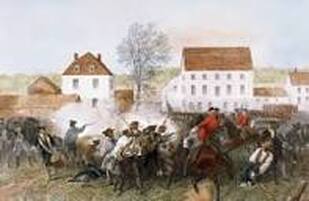 The following is taken from The Story of Liberty, a curriculum and video course on the story of America. To learn more about The Story of Liberty, Click Here. The Beginning of the American Revolution – April 19, 1775 April 19th, 2021 is the 246th anniversary of the beginning of the American Revolution. 246 years ago American farmers and militia fought the “British Regulars” (professional soldiers) at Concord and Lexington and chased the redcoats back to Boston. The fight is sometimes called a skirmish, because it was less than a battle. A little over a year after this fight, Americans declared their right to form a new country with the signing of the Declaration of Independence. The first modern republic was born with the actions of regular citizens rejecting a government that ruled without its consent. The skirmish at Lexington and Concord was fought because the British tried to stop the Americans from preparing for war. In 1774, American leaders at the Continental Congress in Philadelphia petitioned King George III and parliament to restore their rights. When the king and parliament refused and continued to hold the people of Boston under martial law, the Americans decided to mobilize for war. Colonists established illegal, revolutionary governments, collected taxes to fund militia and even funerals for soldiers, and established arsenals, which are warehouses for guns and ammunition. Americans were already well-armed, with each family owning several guns. However, men in villages now trained as soldiers. Some, called minutemen, were chosen and financially supported by town leaders to be prepared to fight within a minute’s notice. General Gage, the commander of the British army in Boston, wanted to surprise the colonists. He ordered Major Pitcairn to march 1,000 soldiers 20 miles to Concord to destroy colonial ammunition and to arrest Samuel Adams and John Hancock. Gage did not want a fight, but wanted take weapons from Americans so they could not fight. However, Americans in Boston learned of this plan and destroyed the surprise. On the night of April 18th, 1775, a Bostonian set two lanterns in the belfry tower of the Old North Church, thus signaling three riders, Dr. Samuel Prescott, William Dawes and Paul Revere, that the British would go to Concord initially by a sea route. The three riders set off from Boston to Concord, warning the colonists “The Regulars are coming! The Regulars are coming!” The “Regulars” were the professional British soldiers. The three successfully alerted the colonists to arm themselves and meet the British. On the morning of April 19th, 1775, the American Revolution started. The British Regulars met American militia assembled in Lexington, a village along the road to Concord. When the Regulars met the Americans, it was dark. Major Pitcairn ordered the Americans to disperse. They just stood there. Then, inexplicably, a shot rang out and the fighting started. The British killed eight and the Americans scattered. The British continued their march to Concord. In Concord, the British found the weapons and destroyed them. However, the Americans managed to defeat a smaller group of the British at the Old North Bridge, and this victory energized the colonists. The British were now twenty miles away from Boston, in the middle of hostile territory. For the rest of the day, the Regulars marched back to the city, drums beating, in formation, along a narrow road. During this march, Americans took aim at the soldiers, firing behind trees, stone walls, and fences, and then running away when any British soldier would chase them. By the end of the day, Americans had killed nearly 300 British and had lost 85 men. Though a small victory, it was seen as a great triumph of Americans over the strongest empire in the world. Questions
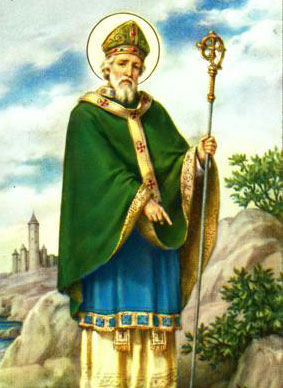 Saint Patrick is one of Christianity's most well-known missionaries. Patrick was born in fourth century Roman Britain (c. 390-461) to a loving family of wealth. His parents were most likely successful merchants and administrators of the Roman Empire. On February 27, 380, Roman Emperor Theodosius issued the Edict of Thessalonica and declared the official religion in the empire to be the Catholic Church. Patrick was brought up in this faith. He had a privileged childhood as the son of wealthy Roman leaders of Britain, but suffered great hardships for a number of years. Patrick brought Christianity to the Irish and changed the course of history. At the beginning of the medieval ages, many in Europe clung to the pagan religions of the past. Ireland, the island to the west of Britain, was a land where Christianity was unknown. Celts in Ireland followed a belief called Druidism. They believed in many gods, and Druid priests had many practices that we would call barbaric. Druids sacrificed humans to keep their gods happy. As a sixteen year-old, Patrick’s easy life of comfort and prestige changed forever. Some reports state Patrick had snuck out of his parents’ home and took part in an all-night pagan ritual. Patrick was raised Catholic Christian, but as a young person, he strayed away from his faith and attended this pagan ritual. With dawn breaking, a small band of Irish pirates raided Britain and captured Patrick. He was taken to Ireland and sold into slavery, completely separated from his loving parents. Patrick wrote later that he had left the faith of his family, and for this he was being punished. For six years, Patrick worked as a common slave in Ireland. At any instant, he could be killed, mutilated, or beaten by his owner. He was far from his home and far from any help his Christian friends could provide. Instead of becoming desperate and sad, though, Patrick spent his time in prayer and reflection. Working as a shepherd for six years, he grew to love the Irish land and people, and yearned to one day teach them the Christian belief. He united his sufferings as a slave to the sufferings of his savior, Christ, and his love for his captors grew. According to Patrick’s writings, he heard the Heavenly Father speak to him and tell him to escape from slavery and to walk to the coast. A boat would be waiting for him. As a slave, if he were recognized, he would have been put to death! Patrick did as he was told, and there was a boat waiting for him. The captain agreed to take him back to Britain. Patrick’s parents were so excited to see him, but they were also disappointed to hear what he wanted to do. He wanted to become a priest and return to the people who enslaved him in Ireland. His parents wanted him to get married, become wealthy and important, and raise a family. If he returned to Ireland, wouldn’t he be killed by his former slave owner for escaping? How could he have a family if he became a priest? Patience is a virtue Patrick practiced. He went to Gaul (France), studied to become a priest, and waited for his calling to go back to Ireland and spread Christianity. At the age of 49, after about 25 years of waiting, he finally received the order to go to Ireland as a bishop to evangelize. He returned, went to his former slave owner, and spoke about Christ. Amazingly, within Bishop Patrick’s lifetime, Ireland became a Christian country! And, since this time Irish missionaries have travelled throughout the world spreading the news of Jesus and his Church. There are many legends attributed to Patrick in Ireland. For example, some say he chased all the snakes out of Ireland, or that he used a three-leaf clover to explain the Trinity. But, what is not legend is that within his lifetime, Ireland changed from a land of slavery, human sacrifice, and paganism, to a Catholic Christian land, where the slave trade came to a halt, and where murder and tribal warfare decreased. Along with bringing Christianity to the Irish, Patrick established monasteries that some say saved Western civilization. In the Middle Ages, a monastery was a place where men lived and worshipped, served as doctors and nurses, fed the poor, took care of orphans, and copied important documents. It was the only place of learning in the first centuries after the Roman Empire fell. As Roman law and order gave way to chaos, Irish monks kept working, copying classic texts of the west, and spreading Christianity. For centuries after Patrick died, Irish monks spread both the Christian faith and the classics. It is for this that some historians claim that St. Patrick saved Western Civilization. To read the writings of Saint Patrick: http://www.archive.org/details/writingsofsaintp00patr Lesson Ideas for Ages 3-11: 1. Look up Ireland on a map. Sketch your own drawing of Ireland and Britain and the rest of continental Europe, or, find a map outline. Color in Ireland green. Ireland is known for being green because it rains so much in Ireland. “Irish weather” means that it is misty and wet outside. This weblink has an excellent outline map of Ireland: 2. Writing Ideas for Ages 12 and older (and for high achieving younger kids!) a. Take the biography of St. Patrick and try to write one sentence that summarizes each paragraph. b. Answer this question in a one-paragraph essay, “Was Patrick’s decision to become a priest and return to Ireland crazy, or was it courageous?” It is late evening, somewhere in Central Europe, and three seemingly incongruent beings are roaming the cities, villages, and mountain towns of this small Slavic land. One is dressed as a bishop from the fourth century, complete with white robe, white beard and mustache, a shepherd’s staff, and mitre (bishop’s hat). Another is wearing horns, dark make-up, black clothes, and a red cape. He is jangling a long and heavy chain and has a black bag he keeps opening up in a threatening manner towards children. The third is an angel, wearing a white robe and wings. The “bishop” and “angel” are smiling gently. The bishop is carrying a bag of goodies to hand out to good kids, while the “devil” is laughing wickedly, jangling his chains, and looking for kids to put in his bag.
As the three visit homes and churches, children are brought to them. The bishop asks the children and parents if they had behaved well the previous year. Before the children can answer, the devil cackles loudly, menacingly jangles his chain, and says, “I know you’ve been a naughty child. You will come with me in my bag and I will take care of you forever.” At this moment, the child comes forth and sings a song, or recites a poem. Little “Jan” assures the bishop and devil that he has been a very good boy. The devil grimaces in pain, and says, “I thought for sure I would get this one.” The angel says, “I knew he was a good boy this year.” Little Jan sighs in relief, receives either a piece of fruit or candy, and the older kids and the parents laugh. Every year, on the evening of December 5th in the Czech Republic, this play is acted out by thousands of bishops, angels, and devils and millions of families. The bishop, angel, and devil and parents are partners in teaching the children to be good in a way that reminds them of the ramifications of their behavior on Earth. December 6th is the day set aside in the Roman Catholic Church to remember Saint Nicholas (Svaty Mikulas in Czech). Saint Nicholas was a fourth century bishop who lived on the Mediterranean Sea in the Roman Empire, in present-day Turkey. During Bishop Nicholas’ lifetime, stories abounded of his generosity and of miraculous events associated with him. One story is how a poor family that was considering to sell their daughters into slavery received golden apples by a mysterious person they believed to be Nicholas. Another story is how Nicholas appeared to distressed sailors on the ocean and calmed the seas. Bishop Nicholas was known by all to be incredibly generous to children. (In America, we call him “Santa Claus.”) In the ninth century, Greek missionaries Cyril and Method converted the Slavic peoples to Christianity and created the various Slavic alphabets. Stories of Saint Nicholas’ generosity spread throughout the Slavic lands and throughout the Christian world. Sometime in the Medieval Ages, the tradition of the benevolent bishop and malevolent devil visiting families began. Originally, children were questioned on their knowledge of the Bible. Today, though, the kids get to escape the devil’s snares by reciting a poem or singing a song. Nearly all Czech families participate in this tradition, which often takes place in the middle of St. Nicholas parties. Similar festivities on the eve or day of St. Nicholas take place throughout Europe and in some parts of the United States. In many places, it has become a secular holiday, including the Czech Republic. Since the Communist rule of this land from 1948-1989, most Czechs are professed atheists. However, they all still partake in the Svaty Mikulas festitivies, and it appears the children are strongly influenced by Bishop Nicholas, the angel and the devil to be good kids for at least one more year. Questions: 1. What day are the Czechs celebrating on December 6th? 2. Why are they celebrating this person? 3. During which years did the Communists control Czechoslovakia? 4. Name one effect Communist rule most likely had on Czechs? 5. What do Americans call Saint Nicholas? On May 9, 2021, Americans will honor their moms by bringing them flowers, taking them out to eat, and spending time visiting either by phone or in person. Because of the coronavirus lockdowns, this year will be more challenging to honor moms, but children will go to great lengths to thank the woman that gave them life. When did this idea of celebrating mothers begin and how did it come to America?
Thousands of years ago, in ancient Greece and Rome, pagans held spring festivals honoring their mother goddesses. Rhea is the Greek mythological mother of the Olympian gods and goddesses and was worshipped as the goddess of fertility and the mountain wilds. In statues, Rhea is depicted as a matronly woman, seated on a throne flanked by lions. In ancient Rome, Romans celebrated “Magna Mater” (Great Mother), however, these celebrations became so wild and notorious that the Roman government banned Magna Mater’s followers from Rome. What do mothers and wild parties have in common? Ask the ancient, pagan Romans. They had a way with parties. During the first centuries after the crucifixion of Christ, early Christians celebrated Mary as the mother of God, “Theotokos” in Greek and “Mater Dei” in Latin. By the 7th century, Christians around the world set aside January 1st as a special day to honor Mary. In America, Mother’s Day was the brainstorm of Anna Jarvis in 1868. Jarvis wanted to establish a day where Americans would unite for peace and friendship. In 1868, she created a committee to establish “Mother’s Friendship Day,” a day set aside for former Civil War combatants and their families to reunite and form friendships. When Jarvis died, her daughter, also Anne Jarvis, took up the call. Anne Jarvis wanted a day to honor all moms and was upset that America’s holidays were too male dominated. Jarvis sponsored the first U.S. celebration of Mother’s Day at St. Andrew’s Methodist Church in Grafton, West Virginia, in the early 1900s. Anne Jarvis was so successful in promoting the holiday that in 1914, the U.S. Congress passed a law designating the second Sunday in May as Mother’s Day. President Wilson issued a proclamation that on the first Mother’s Day, Americans should show the flag in honor of those mothers whose sons had died in war. Mother’s Day has become a major American and commercial holiday. It is the third largest holiday for sending cards. Americans take their mothers out for brunches or lunch on Mother’s Day, and it has become a source of great wealth for the card, restaurant, and flower industries. The founder of Mother’s Day, Anne Jarvis, decried the commercialization of the holiday she championed. In fact, in 1948, Jarvis was arrested for disturbing the peace during a protest against Mother’s Day! The Classical Historian family expresses great admiration and gratitude to all mothers. In many ways, mothers are responsible for passing on culture, manners, standards, education, and morality. The author of this article is the 10th of 11 children. He’s glad his mom sacrificed so much to give life and love to so many. Thanks Mom! And we wish all moms this Sunday, a Happy Mother’s Day! Harriet Tubman’s image will replace Andrew Jackson’s image on the front of the $20 bill, beginning sometime after 2020. Jackson’s image will move to the back of the bill. During Harriet Tubman’s life, she was hated by the Southern Democrats but loved by the party of Lincoln, the Republicans. Because of the change of the $20 bill, Tubman’s life and meaning has become again a controversial topic for the United States of America.
Harriet Tubman was an escaped slave who risked her life to free others. Born a slave in Maryland, we believe her birth date was 1822, though we are unsure because slaveholders tried to take away any birthday celebrations for slaves. It was believed that if a slave didn’t think she was special, she would follow orders better. Some time in her young adulthood, Tubman escaped and travelled along the Underground Railroad until she made it to Pennsylvania, a free state. After making it to freedom, she returned South numerous times to rescue dozens of slaves. Escaping from slavery was dangerous, but this did not stop Tubman from returning to the South to rescue more slaves. She travelled on the Underground Railroad. This was a secret system of families, mainly white, who sheltered and fed escaped slaves during the day at their homes, called “stations”. At nighttime, the slaves continued on the “railroad” until they made it to another station, or into the North. Tubman acted as a conductor, a person who led the slaves along the railroad. Harriet Tubman carried a gun while a conductor on the Underground Railroad. Running away from slavery into the unknown was so terrifying, that some slaves wanted to return to their masters while on the journey to freedom. If a slave started to turn back, Tubman would point the gun at these individuals and threaten to shoot if they returned. Tubman knew the slave master would torture the slave until he found out information where the other runaways were. Unlike Andrew Jackson who was the founder of the modern Democratic Party, Harriet Tubman was a lifelong Republican, even acting as a spy against the southern slaveholding Democrats during the Civil War (1861-1865). Tubman reportedly had hundreds of intelligence contacts and could easily gain the trust of slaves in the South. In one scouting mission, she became the first woman to command a significant number of American troops in combat. This action freed more slaves than all of her journeys on the Underground Railroad. Harriet Tubman was a devout Christian and believed she gained her strength and courage to help others from her belief throughout her lifetime. After the Civil War, she helped to found a church and a retirement home. She also fought for woman’s suffrage and fair treatment of black Civil War veterans. Harriet Tubman died in 1913, loved by the North and the slaves she had freed. Irony One definition of irony is "a state of affairs or an event that seems deliberately contrary to what one expects and is often amusing as a result." It is ironic that the Obama administration is replacing Andrew Jackson with Harriet Tubman on the front of the $20 bill. Jackson is the modern founder of the Democratic Party. President Obama is the leader of the Democratic Party. Jackson was a populist, and Obama campaigned as one. Tubman was hated by Democrats and loved by Republicans. She was a gun-carrying, Republican Christian, the exact person that President Obama continues to speak and act against. It is ironic that under a Democratic administration that is against civilian use of weapons, that Harriet Tubman is replacing the founder of the Democratic Party on the $20 bill. Questions
By John De Gree of www.classicalhistorian.com Copyright 2016. All Rights Reserved.  The following is taken from The Story of Liberty, a curriculum and video course on the story of America. To learn more about The Story of Liberty, Click Here. The Beginning of the American Revolution – April 19, 1775 April 19th, 2016 is the 243rd anniversary of the beginning of the American Revolution. 243 years ago American farmers and militia fought the “British Regulars” (professional soldiers) at Concord and Lexington and chased the redcoats back to Boston. The fight is sometimes called a skirmish, because it was less than a battle. A little over a year after this fight, Americans declared their right to form a new country with the signing of the Declaration of Independence. The first modern republic was born with the actions of regular citizens rejecting a government that ruled without its consent. The skirmish at Lexington and Concord was fought because the British tried to stop the Americans from preparing for war. In 1774, American leaders at the Continental Congress in Philadelphia petitioned King George III and parliament to restore their rights. When the king and parliament refused and continued to hold the people of Boston under martial law, the Americans decided to mobilize for war. Colonists established illegal, revolutionary governments, collected taxes to fund militia and even funerals for soldiers, and established arsenals, which are warehouses for guns and ammunition. Americans were already well-armed, with each family owning several guns. However, men in villages now trained as soldiers. Some, called minutemen, were chosen and financially supported by town leaders to be prepared to fight within a minute’s notice. General Gage, the commander of the British army in Boston, wanted to surprise the colonists. He ordered Major Pitcairn to march 1,000 soldiers 20 miles to Concord to destroy colonial ammunition and to arrest Samuel Adams and John Hancock. Gage did not want a fight, but wanted take weapons from Americans so they could not fight. However, Americans in Boston learned of this plan and destroyed the surprise. On the night of April 18th, 1775, a Bostonian set two lanterns in the belfry tower of the Old North Church, thus signaling three riders, Dr. Samuel Prescott, William Dawes and Paul Revere, that the British would go to Concord initially by a sea route. The three riders set off from Boston to Concord, warning the colonists “The Regulars are coming! The Regulars are coming!” The “Regulars” were the professional British soldiers. The three successfully alerted the colonists to arm themselves and meet the British. On the morning of April 19th, 1775, the American Revolution started. The British Regulars met American militia assembled in Lexington, a village along the road to Concord. When the Regulars met the Americans, it was dark. Major Pitcairn ordered the Americans to disperse. They just stood there. Then, inexplicably, a shot rang out and the fighting started. The British killed eight and the Americans scattered. The British continued their march to Concord. In Concord, the British found the weapons and destroyed them. However, the Americans managed to defeat a smaller group of the British at the Old North Bridge, and this victory energized the colonists. The British were now twenty miles away from Boston, in the middle of hostile territory. For the rest of the day, the Regulars marched back to the city, drums beating, in formation, along a narrow road. During this march, Americans took aim at the soldiers, firing behind trees, stone walls, and fences, and then running away when any British soldier would chase them. By the end of the day, Americans had killed nearly 300 British and had lost 85 men. Though a small victory, it was seen as a great triumph of Americans over the strongest empire in the world. Questions
Throughout the month of April, use the Coupon Code Jefferson when checking out and receive 10% off all products and services.
by John De Gree, Founder of the Classical Historian American Founding Father Thomas Jefferson was an American Founding Father who established political and cultural traditions that Americans still enjoy today. He was born on April 13, 1743, in the English colony of Virginia, in a prominent family. His father was a surveyor and cartographer and created the first accurate map of Virginia. From what we would call a large family, Jefferson had 9 siblings: six sisters, one brother, and two who died before the age of two. Like George Washington, Thomas experienced tragedy at a young age when he lost his father. Most likely, Jefferson learned how to read from his mom, Jane Jefferson, and his education was geared towards training him to strive for goodness and beauty and to become a leader. Before his formal education began at the age of 9, he spent his time reading, learning to play the violin, and playing in the woods. For five years thereafter, the Reverend William Douglas taught him Latin and Greek at a private school. When his father died, Jefferson continued his studies under the Reverend James Maury, who Jefferson describes as “a correct classical scholar.” This meant that Thomas Jefferson studied the great thinkers of Classical Greece and Rome, and strove for self-improvement by learning about the great ideas and lives of those in history. At the college of William and Mary in Virginia, Thomas Jefferson initially chose not to be a man of character. He spent his first months at parties, playing cards, and betting. After coming home for a visit, a friend was disappointed that Thomas wasn’t applying himself. Thomas chose from then on to take his studies seriously. Professor William Small, Lieutenant Governor Francis Fauquier and lawyer George Wythe led a small group of scholars, recommending books to read and leading discussion sessions. Under this personal care, Thomas Jefferson developed into a deep thinker and leader. After college, Jefferson studied law under the private guidance of Wythe, studying five years instead of the normal two and a half. He became one of the country’s most educated lawyers. Thomas Jefferson’s personal life was filled with much sorrow. Jefferson married Martha Wayles Skelton, and together they had six children. Four died before adulthood, and only one outlived Thomas. Martha died after ten years of marriage of diabetes. Thomas Jefferson shut himself in his room and paced for three weeks. He had promised his wife he would not remarry, and he did not. Whereas George Washington was a great military man, Jefferson’s genius lay in the power of his pen, his legislative work, and his Presidential leadership. He served in the Virginia House of Burgesses, which was the Virginia colony’s legislative body. Jefferson authored the Virginia Statute for Religious Freedom, which was used as a guide for our country’s First Amendment. He wrote to A Summary View of the Rights of British America, which declared that the colonies had the right to self-govern. Jefferson was a participant in the First Continental Congress and the Second Continental Congress, and pushed for independence from Great Britain. Jefferson served as governor of Virginia and was the Washington’s Secretary of State. He is the principal author of The Declaration of Independence, one of the most powerful and beautiful political documents of all time. Perhaps the most memorable sentence he wrote is, “We hold these truths to be self-evident, that all men are created equal, that they are endowed by their Creator with certain unalienable Rights, that among these are Life, Liberty and the pursuit of Happiness.” s the young nation’s third President, Jefferson doubled the size of the United States, kept the country out of war with France and Britain, and kept American shipping safe in the Mediterranean by destroying pirates. Historians call time from 1800 to about 1820 “The Age of Jefferson” because of America’s accomplishments that Jefferson started. France’s Napoleon Bonaparte eagerly sold the Louisiana Territory to Jefferson to help pay for his war against Great Britain. Curious to learn of this new land, Jefferson sent 40 men and one woman on an incredible journey. The Lewis and Clark Expedition explored and mapped this new land. Jefferson’s foreign policy towards belligerent countries is mixed. Some have criticized Jefferson for keeping a small military and allowing Great Britain and France to harass and imprison our sailors, but Jefferson thought we would lose a war against one of these great powers and it was best to appease than to confront them. When Barbary pirates were seizing American ships and killing American sailors, Jefferson ordered an invasion of Tripoli and our military forced the pirates to stop harming Americans. Although Jefferson was a Democratic-Republican and favored states’ rights, he ordered the purchase of Louisiana without Congressional approval, a violation of the Constitution. On July 4, 1826, the fiftieth anniversary of the Declaration of Independence, Thomas Jefferson died, a few hours before his friend and the second President John Adams. Of all his accomplishments, Jefferson was most proud of a few. He wrote his own epitaph, which reads: HERE WAS BURIED THOMAS JEFFERSON AUTHOR OF THE DECLARATION OF AMERICAN INDEPENDENCE OF THE STATUTE OF VIRGINIA FOR RELIGIOUS FREEDOM AND FATHER OF THE UNIVERSITY OF VIRGINIA. Questions
John De Gree is Founder of The Classical Historian, www.classicalhistorian.com. You may reach him at [email protected]. ©2016 John De Gree All Rights Reserved. |
John De GreeJohn De Gree writes the current events with a look at the history of each topic. Articles are written for the young person, aged 10-18, and Mr. De Gree carefully writes so that all readers can understand the event. The perspective the current events are written in is Judeo-Christian. Receive Articles and Coupons in Your EmailSign Up Now
For Email Marketing you can trust. Archives
June 2024
Categories
All
|
|
SUPPORT
|
RESOURCES
|
|


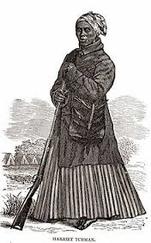
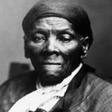


 RSS Feed
RSS Feed



